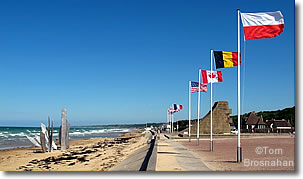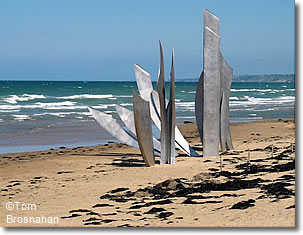|
|
|
To visit Omaha Beach today is to see the small French seaside towns such as Vierville-sur-Mer or Colleville-sur-Mer, 22 km (14 miles) northwest of Bayeux. Families walk on the beach, children play in the sand, and the streets are lined with small holiday homes. At a glance, it could look like any other seaside town. But on June 6, 1944, this area was anything but peaceful. As one of the major landing sites of D-Day, the code-named "Omaha Beach" was a bloody battle. Sea conditions resulted in the troops not being able to control their landings as planned. The German defenders were well armed and organized and waiting behind the cliffs that line the beach. As everyone knows, thousands of soldiers died on the beach or while trying to reach it. Many more died trying to break through the German defenses. Omaha Beach recalls the bravery of those soldiers as they continued to fight and eventually to secure the beachhead. Even after being examined in many books and movies, the enormous reality of what happened on Omaha Beach is hard to comprehend until you stand here. Today a modern sculpture memorializes D-Day, and the Normandy American Cemetery and Memorial at Colleville-sur-Mer looks down upon the beach just a short walk away. Throngs of visitors come to see where it all took place, and they leave sobered by what they've seen. A short drive from Utah Beach, Pointe du Hoc, Ste-Mère-Église and other famous D-Day sites, Omaha Beach is a frequent stop for guided tours and individual travelers alike. Many organizations offer tours of the D-Day beaches, or you can drive along the coast yourself and visit a variety of sites. Most small towns in Normandy—including the towns around Omaha—have museums that provide more specific information and exhibits about D-Day. In addition, the Memorial de Caen Museum provides extensive information about D-Day and its aftermath.
|
|
Above, Memorial and flags, Omaha Beach, Normandy, France.
|



